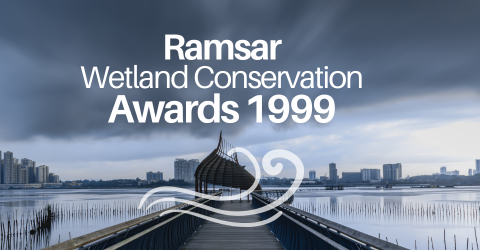
Government/Non-governmental Coalition Award 1999
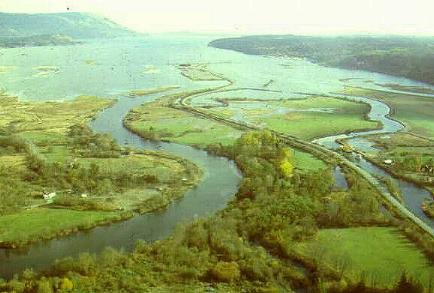
Pacific Estuary Conservation Program (PECP), Canada
Since its creation in 1987, the Pacific Estuary Conservation Program has excelled in its goal of conserving and insuring the long-term sustainable use of estuarine habitat along the coast of British Columbia in Canada.
Although they comprise less than 3% of the entire British Columbia shoreline, estuaries are used by 80% of all coastal wildlife. They include areas of national and international significance and are important resting and feeding sites along the Pacific Flyway. Their conservation and sustainable use is challenged by the fact that they are located in the fastest growing socio-economic region of Canada.
The Pacific Estuary Conservation Program is a coalition of seven governmental agencies and three non-governmental conservation organizations, whose goal is to secure estuary habitat through acquisition, creation of nature reserves, and stewardship of privately-owned land. By coordinating its members’ efforts, focusing their energies and pooling financial and technical resources, the Program has acquired 1,515 hectares and initiated the conservation designation of 45,000 hectares of estuarine and adjacent intertidal habitat. Securing habitat and ensuring its biological integrity has been achieved through community-based approaches and innovative strategies which stand as models to others engaged in similar work
---Contributed article---
Rivers spill from towering, snow-capped mountain ranges along Canada’s rugged west coast to form a chain of wetlands scattered along the expanse of rocky fjords. This string of estuarine jewels are home to the bear, deer, elk and other land mammals roaming their deltas. Salmon fry and other fish congregate in their shallow, silty waters. Seals and otters hunt offshore. For the five million waterbirds that journey along the Pacific Flyway every year, these marshy oases provide food and resting spots during their long migrations. These crucial wildlife habitat areas are being preserved thanks to the efforts of the Pacific Estuary Conservation Program (PECP).
On 10 May 1999, the PECP will receive international recognition by winning the first Ramsar Wetland Conservation Award at the opening ceremony of the Conference of the Contracting Parties to the Convention on Wetlands in San José, Costa Rica. The award comes with the Evian Special Prize (US$10,000), donated by the Danone Group of France.
The PECP will be honored for its contribution to preserving wetlands along the coast of British Columbia (BC), Canada’s Pacific province. The PECP has acquired 1,612 hectares of private land on and around wetlands. More importantly, the PECP has also arranged the transfer and designation of 54,736 hectares of Crown lands for wildlife habitat. All this in twelve years. Additionally, since 1991, the PECP has received significant funding from the Pacific Coast Joint Venture (PJVC), an international partnership with conservation groups, landowners, corporations, and US federal and state agencies in Washington, Oregon and California. The PECP acts as the land acquisition arm of the PCJV in BC. The PCJV falls under the auspices of the North American Waterfowl Management Plan, a strategy to protect important coastal ecosystems.
In 1986, Bert Hoffmeister, then chair of The Nature Trust of BC, had the foresight to try a new, cooperative approach to acquiring land for preservation purposes. A five-agency partnership of conservation agencies and several levels of government was created and they pooled their financial resources to buy wetlands in BC.
Les Bogdan, Manager of Field Operations for Ducks Unlimited Canada (DUC), recalls that "various conservation groups were out there looking at the properties available to purchase and they seemed to be in competition. It didn’t make sense getting into bidding wars on pieces of property."
Besides DUC and The Nature Trust of BC, other partners in the PECP are Wildlife Habitat Canada, the Habitat Conservation Trust Fund, the BC Ministry of Environment Lands and Parks (MELP), and two federal Ministries, the Department of Fisheries and Oceans, and Environment Canada.
"The greatest single achievement has been the bringing together of a very diverse group of participants in areas of conservation to focus on really making a difference to some of the most biologically valuable land in BC", says Ian McTaggart-Cowan, Chair of the Public Advisory Board of the Habitat Conservation Trust Fund.
The fledgling PECP rolled up their collective sleeves and got down to work rating the estuaries based on biological resources and imminence to threat from urban expansion. By focusing their efforts and funds on priority sites, the PECP was able to secure lands in several key estuaries in their first year of operation. Three of these sites are on Vancouver Island:
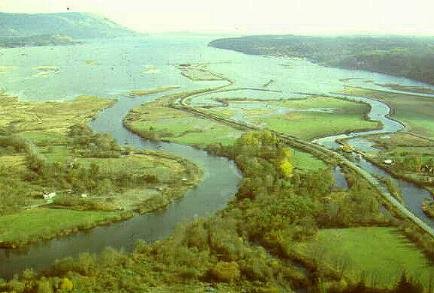
- The Cowichan Estuary (right), where the PECP has secured 300 hectares of intertidal habitat and backshore farmlands.
- The Nanaimo Estuary, the largest estuary on Vancouver Island, where 200 hectares were secured.
- The Englishman Estuary. The PECP proposed a subdivision of an area that was embroiled in a lengthy and bitter struggle between conservationists and developers. 71 hectares of land was purchased to conserve critical intertidal and upland wildlife habitat amidst golf courses, condos and trailer parks. The PECP arranged the transfer of adjacent Crown Lands and assembled 873 hectares for a Wildlife Management Area (WMA), a designation that provides long-term conservation security in BC.
The PECP is working with agricultural communities and other interests in Vancouver Island’s Comox and Courtenay Valleys to protect and enhance farmlands and wetlands.
Though the PECP works to provide wildlife habitats all along BC’s coast, much of its efforts take place in the estuary of the Fraser River, the largest on the Pacific coast of Canada. The Fraser Estuary provides winter refuge for more than 130 species of birds and supports 4 million salmon and 1.4 million birds during peak periods of migration. 30,000 of the Lesser Snow Geese that breed on Wrangel Island roost and feed on the estuary for much of the winter. 100,000 – 200,000 dabbling ducks along with about 20,000 Canada Geese also use the area.
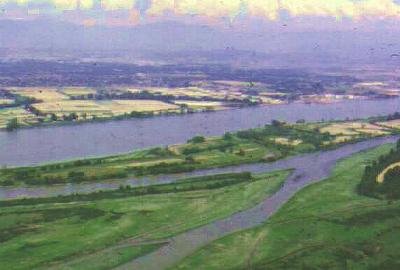
Left: The South Arm of the Fraser River
At the mouth of the Fraser River sits the seaside metropolis of Vancouver. In 150 years Vancouver has changed from aboriginal villages to colonial logging camps to a cosmopolitan port city of nearly two million people. Industry, agriculture, residential housing and wildlife all need the fertile land lying between the US border, the sea, and the tree-covered mountains. Not surprisingly, land in the Fraser delta is the most expensive real estate in BC. The human population has already drastically altered the Fraser Estuary - 70% of the estuary habitat has been diked, drained, and developed. The PECP’s highest priority and perhaps their greatest challenge lies in preserving an ecosystem that sustains wildlife: wetlands and farmlands.
Rick McKelvey, Acting Manager of the Pacific Wildlife Research Center (PWRC), says, "we don’t have any ability to control urban development so we’re pursuing our next best strategy, which is to make sure we reserve some land for wildlife management."
The PWRC sits on the 586-hectare Alaksen National Wildlife Area (NWA) 35 kilometers south of Vancouver on Westham Island in the muddy Fraser River. Alaksen, one of Canada’s 30 Ramsar sites, means "a flat piece of land facing seaward" in the language of the Coast Salish aboriginals. Alaksen provided a model for the PECP who began acquiring bordering lands.
Stretching north of Alaksen past Vancouver’s International Airport are 5,152 hectares of marsh, mud-flat and open water called Sturgeon Bank. Each winter hundreds of thousands of waterfowl, shorebirds and raptors return to the area, sharing the site with 38 species of fish who inhabit the estuary. 800 million juvenile salmon feed, rest and acclimatize to salt water in the tidal marshes. The PECP brokered a consultation process between stakeholders in an area where log storage booms, sewage disposal, undersea utility lines, agriculture, and commercial and recreational fishing all compete for resources. The PECP arranged for the transfer of Crown Lands on Sturgeon Bank to designation as a WMA this past October.
Farther south in the Fraser Estuary is the Boundary Bay WMA, 10.9 hectares of tidal flats and eelgrass beds that are prime habitat for fish and invertebrates and act as migrating, staging, and wintering areas for waterfowl and shorebirds. The PECP is currently working to have Sturgeon Banks, Roberts Banks, and Boundary Bay designated as Ramsar sites.
Like the wildlife pressured by urban sprawl, Fraser Estuary farmers are threatened by forces beyond their control. The rich alluvial soil is guarded from erosion by dikes - there is less protection against the vagaries of the international marketplace. Soil-based farming is losing ground to US and Mexican agriculture, as well as land speculation.
"Farming has never been tougher," says Jack Bates, Director of the Delta Farm and Wildlife Trust, and President of the Delta Farmer’s Institute. "Agriculture and wildlife have gone hand in hand since we started farming here. I think the bird population has really grown here in the past 20 years. I’m 42. I never saw an eagle until I was 12 years old. At this time of year you can look out any window of the house and see one. They’re in the hundreds around here. Agriculture is the reason those birds are here."
Farmlands are the only space available for future development between the sea, the mountains, and the US border. If they fall prey to commercial or industrial development, or are covered in greenhouse glass, they will never go back to farmland. What happens there directly affects the outcome of wildlife habitat preservation in greater Vancouver. Preserving soil-based agriculture figures prominently in the PECP strategy. When key Fraser Estuary lands go up for sale, the PECP tries to buy the property. It is an expensive way to preserve wildlife habitat. But it works.
Bogdan recalls: "the agricultural community was very worried about the PECP buying any farmland because we were viewed as absentee landowners. We had to prove to the farmers that we were doing the right thing, so we guaranteed them that if we bought a farm, we would lease it back to a farmer."
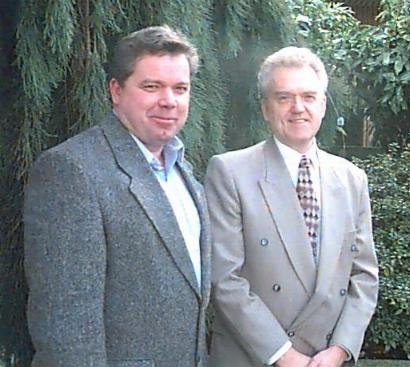
Les Bogdan (left), Manager of Field Operations, Ducks Unlimited Canada, and Ron Erickson, Executive Vice-President of The Nature Trust of British Columbia.
The Delta Farmer’s Institute is informed before purchases are closed to make sure that the PECP has their support. Maintaining their good relationship with BC’s agricultural community is a high priority for the PECP. But with the farmers walking a fine line between profit and loss, the relationship is strained when flocks of ducks and geese descend on planted fields. Thousands of migratory munchers can consume a lot of goodwill in a hurry.
"At one time Alaksen was seen to be a source of some of the farmer’s problems, in that we were attracting birds onto our land that we couldn’t hold here," says McKelvey, from the converted farmhouse. "We tended to grow crops, then leave them for birds. We realized we can’t do that because, for birds, it’s like going to a smorgasbord – they take the best things first. Then they’ll go on to our neighbors’ places. They’ll just keep moving around wherever the best stuff is."
So the PECP picked up the tab by funding a pilot project to provide ‘seed money’ for farmers to grow crops of winter cereals on their lands. The resulting Greenfields Project serves a dual purpose – to improve soil structure with organic material and to disperse damage done on farmlands by American widgeon. Land that may otherwise lie fallow is sown to feed the flocks. The program is administered by the Delta Farm and Wildlife Trust.
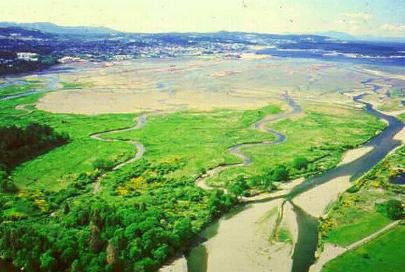
Left: The Nanaimo River Estuary
"I think it’s been very successful", says Bates. "If birds don’t eat it, it’s good for the land. You get some green manure in the spring and summer to plough down."
The PECP is not prepared to rest on its laurels. "Someone said, you can’t win it forever, you can only lose it forever," Rod Silver of the Habitat Conservation Fund says. There are many wetlands still to be protected.
"There are 407 estuaries along the BC coast and some of them are very small, but they’re very important for migrating birds and fish," says Ron Erickson, Executive Vice-President of The Nature Trust. "Without these migrating stopping places the creatures would simply cease to exist," McTaggart-Cowan warns.
Ted Pobran, current chair of the PECP and Senior Habitat Planner for MELP, wants to strengthen the program by adding more partners.
"The First Nations [aboriginals] will be a very important partner for the future," Pobran says. "I would hope that we would develop partnerships with First Nations on specific community initiatives where there are First Nations lands that are important for conservation - and that we could all work together in ensuring the long-term conservation and management of those lands."
In a dozen years the PECP has built a successful partnership that has focused the individual skills and finances of its members to conserve significant estuaries along Canada’s west coast for long-term sustainable use. By inviting consultations with the many industrial, agricultural, government, residential and conservationist stakeholders in BC wetlands, the PECP has established a strong presence at negotiating tables for wildlife habitat in BC, Canada’s most biologically diverse province. The PECP will receive their Ramsar Wetland Conservation Award on May 10, farther south down the Pacific Flyway in San José, Costa Rica.